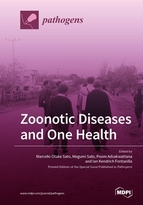Zoonotic Diseases and One Health
A special issue of Pathogens (ISSN 2076-0817).
Deadline for manuscript submissions: closed (31 May 2019) | Viewed by 53821
Special Issue Editors
Interests: one-health; eco-health; parasitology; zoonosis; eco-epidemiology; surveillance; control of infectious diseases
Special Issues, Collections and Topics in MDPI journals
Interests: Foodborne Parasites
Interests: Molecular biology and parasitology; Immunology
Interests: molecular phylogenetics; medical malacology
Special Issues, Collections and Topics in MDPI journals
Special Issue Information
Dear Colleagues,
Humans are part of an ecosystem and understanding our relationship with the environment and with other organisms is a prerequisite to living together sustainably.
Zoonotic diseases are an important issue as they reflect our relationship with other animals in a common environment. Zoonoses are still presented with high occurrence rates, especially in rural communities, with direct and indirect consequences for people. In several cases, zoonosis could cause severe clinical manifestations and is difficult to control and treat. Moreover, the persistent use of drugs for infection control enhances the potential of drug resistance and impacts on the ecosystem balance and food production.
In this regard, it is important for us to understand zoonosis in terms of how it allows ecosystems to transform, adapt and evolve. Eco-health/one-health approaches recognize the interconnections among people, other organisms, and their shared developing environment. Moreover, these holistic approaches encourage stakeholders of various disciplines to collaborate in order to solve problems related to zoonosis.
The reality of climate change necessitates considering new variables in studying diseases, particularly to predict how these changes in the ecosystems can affect human health and how to recognize the boundaries between medicine, veterinary care, environmental and social changes towards healthy and sustainable development.
In this Special Issue of Pathogens, we hope to consolidate studies on basic and applied studies of zoonotic pathogens from various agents with different points of view. Therefore, we invite you to submit original and review articles covering all the important aspects of zoonotic diseases with one-health and eco-health perspectives.
We look forward to your contribution.
Dr. Marcello Otake Sato
Dr. Megumi Sato
Dr. Poom Adsakwattana
Dr. Ian Kendrich Fontanilla
Guest Editors
Manuscript Submission Information
Manuscripts should be submitted online at www.mdpi.com by registering and logging in to this website. Once you are registered, click here to go to the submission form. Manuscripts can be submitted until the deadline. All submissions that pass pre-check are peer-reviewed. Accepted papers will be published continuously in the journal (as soon as accepted) and will be listed together on the special issue website. Research articles, review articles as well as short communications are invited. For planned papers, a title and short abstract (about 100 words) can be sent to the Editorial Office for announcement on this website.
Submitted manuscripts should not have been published previously, nor be under consideration for publication elsewhere (except conference proceedings papers). All manuscripts are thoroughly refereed through a single-blind peer-review process. A guide for authors and other relevant information for submission of manuscripts is available on the Instructions for Authors page. Pathogens is an international peer-reviewed open access monthly journal published by MDPI.
Please visit the Instructions for Authors page before submitting a manuscript. The Article Processing Charge (APC) for publication in this open access journal is 2700 CHF (Swiss Francs). Submitted papers should be well formatted and use good English. Authors may use MDPI's English editing service prior to publication or during author revisions.
Keywords
- Zoonoses
- One-Health
- Eco-health
- Infectious diseases
- Foodborne/Waterborne diseases
- Molecular biology
- Eco-epidemiology
- Diagnosis
- Alternative strategies
- Medical Anthropology










